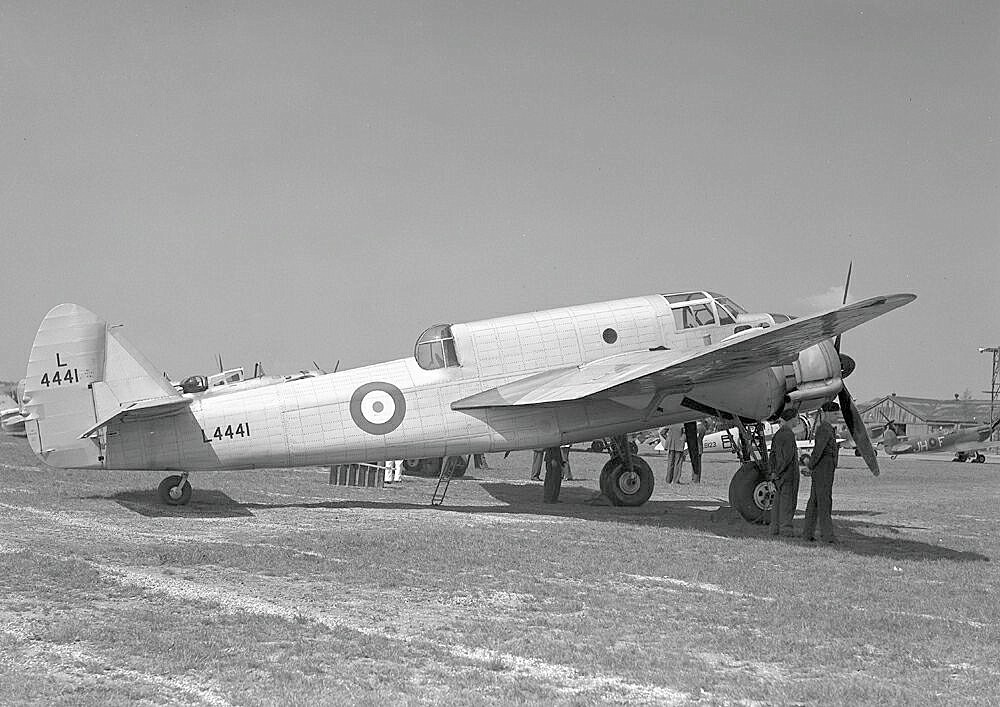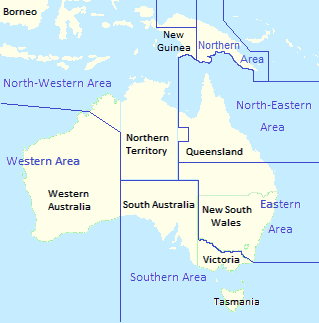|
1st Tactical Air Force RAAF
The Australian First Tactical Air Force (No. 1 TAF) was formed on 25 October 1944 by the Royal Australian Air Force (RAAF). Its purpose was to provide a mobile force of fighter and ground attack aircraft that could support Allied army and naval units fighting the Empire of Japan in the South West Pacific Area. One of several Allied tactical air forces formed during World War II, it evolved from the RAAF's No. 10 Operational Group, established a year earlier. Following action in the assaults on Aitape and Noemfoor, the group was renamed the First Tactical Air Force to better reflect its size and role. It was beset with morale and leadership issues in early 1945, but recovered to take part in the battles of Tarakan, North Borneo, and Balikpapan. Reaching its peak strength of over 25,000 personnel in July 1945, No. 1 TAF's squadrons operated such aircraft as the P-40 Kittyhawk, Supermarine Spitfire, Bristol Beaufighter, and B-24 Liberator. The formation remained active fol ... [...More Info...] [...Related Items...] OR: [Wikipedia] [Google] [Baidu] |
Royal Australian Air Force
"Through Adversity to the Stars" , colours = , colours_label = , march = , mascot = , anniversaries = RAAF Anniversary Commemoration – 31 March , equipment = , equipment_label = , battles = * Second World War * Berlin Airlift * Korean War * Malayan Emergency * Indonesia–Malaysia Confrontation * Vietnam War * Operation Astute, East Timor * War in Afghanistan (2001–present), War in Afghanistan * Iraq War * American-led intervention in Iraq (2014–present), Military intervention against ISIL , decorations = , battle_honours = , battle_honours_label = , flying_hours = , website = , commander1 = Governor-General of Australia, Governor-General David Hurley as representative of Charles III as Monarchy ... [...More Info...] [...Related Items...] OR: [Wikipedia] [Google] [Baidu] |
Landing At Aitape
The Landing at Aitape (code-named Operation Persecution) was a battle of the Western New Guinea campaign of World War II. American and Allied forces undertook an amphibious landing on 22 April 1944 at Aitape on northern coast of Papua New Guinea. The amphibious landing was undertaken simultaneously with the landings at Humboldt and Tanahmerah Bays to secure Hollandia to isolate the Japanese 18th Army at Wewak. Operations in the area to consolidate the landing continued until 4 May, although US and Japanese forces fought further actions in western New Guinea following a Japanese counter-offensive that lasted until early August 1944. Aitape was subsequently developed into an Allied base of operations and was used by Australian forces throughout late 1944 and into 1945 during the Aitape–Wewak campaign. Background Aitape, located on the northern coast of the Territory of New Guinea about southeast of Hollandia, was occupied by the Japanese during December 1942. The Japanese bui ... [...More Info...] [...Related Items...] OR: [Wikipedia] [Google] [Baidu] |
Bristol Beaufort
The Bristol Beaufort (manufacturer designation Type 152) is a British twin-engined torpedo bomber designed by the Bristol Aeroplane Company, and developed from experience gained designing and building the earlier Blenheim light bomber. At least 1,180 Beauforts were built by Bristol and other British manufacturers. The Australian government's Department of Aircraft Production (DAP) also manufactured variants of the Beaufort. These are often known collectively as the DAP Beaufort. More than 700 Australian-built Beauforts saw service with the Royal Australian Air Force in the South West Pacific theatre, where they were used until the end of the war. Beauforts first saw service with Royal Air Force Coastal Command and then the Royal Navy Fleet Air Arm from 1940. They were used as torpedo bombers, conventional bombers and mine-layers until 1942,Robertson 1976, p. 30. when they were removed from active service and were then used as trainer aircraft until being declared obsolete i ... [...More Info...] [...Related Items...] OR: [Wikipedia] [Google] [Baidu] |
A-20 Havoc
The Douglas A-20 Havoc (company designation DB-7) is an American medium bomber, attack aircraft, night intruder, night fighter, and reconnaissance aircraft of World War II. Designed to meet an Army Air Corps requirement for a bomber, it was ordered by France for their air force before the USAAC decided it would also meet their requirements. French DB-7s were the first to see combat; after the fall of France, the bomber served with the Royal Air Force under the service name Boston. From 1941, night fighter and intruder versions were given the service name Havoc. In 1942 USAAF A-20s saw combat in North Africa. It served with several Allied air forces, principally the United States Army Air Forces (USAAF), the Soviet Air Forces (''VVS''), Soviet Naval Aviation (''AVMF''), and the Royal Air Force (RAF) of the United Kingdom. A total of 7,478 aircraft were built, of which more than a third served with Soviet units. It was also used by the air forces of Australia, South Africa, Fra ... [...More Info...] [...Related Items...] OR: [Wikipedia] [Google] [Baidu] |
Madang
Madang (old German name: ''Friedrich-Wilhelmshafen'') is the capital of Madang Province and is a town with a population of 27,420 (in 2005) on the north coast of Papua New Guinea. It was first settled by the Germans in the 19th century. History Russian biologist Nicholai Miklukho-Maklai was probably the first European to visit the area. In 1871 he stayed at Astrolabe Bay south of present-day Madang for 15 months. He had a good relationship with the local communities before leaving, suffering from malaria. In April 1884 an expedition by the German New Guinea Company led by Otto Finsch and Eduard Dallmann arrived and named the landing point "Friedrich Wilhelmshafen"; however, they felt that the area was unsuitable for a settlement. A subsequent survey in 1888 mentioned good soil conditions that would make a coffee plantation possible. In the summer of 1891 a station was built and by September 1892 was the seat of the provincial administration; however, the Imperial Government ... [...More Info...] [...Related Items...] OR: [Wikipedia] [Google] [Baidu] |
Fifth Air Force
The Fifth Air Force (5 AF) is a numbered air force of the United States Air Force Pacific Air Forces (PACAF). It is headquartered at Yokota Air Base, Japan. It is the U.S. Air Force's oldest continuously serving Numbered Air Force. The organization has provided 80 years of continuous air power to the Pacific since its establishment in September 1941. Fifth Air Force is the Headquarters Pacific Air Forces forward element in Japan, and maximizes partnership capabilities and promotes bilateral defense cooperation. In addition, 5 AF is the air component to United States Forces Japan. Its mission is three-fold. First, it plans, conducts, controls, and coordinates air operations assigned by the PACAF Commander. Fifth Air Force maintains a level of readiness necessary for successful completion of directed military operations. And last, but certainly not least, Fifth Air Force assists in the mutual defense of Japan and enhances regional stability by planning, exercising, and executing ... [...More Info...] [...Related Items...] OR: [Wikipedia] [Google] [Baidu] |
Nadzab
Nadzab Village is in the Markham Valley, Morobe Province, Papua New Guinea on the Highlands Highway. Administratively, it is located in Gabsongkeg ward of Wampar Rural LLG. The Nadzab Airport is located East of Nadzab Village and was the site of the only Allied paratrooper assault in New Guinea on 5 September 1943. Location Nadzab is located on the Erap River, North of the Markham River and 42 km North West of Lae. The settlements of Gabmatsung/Gabmatzung and Gabsonkek are located on the East side of the airport. Grasslands The present distribution of grasslands in New Guinea is a product of forest clearance and/or burning by man. Lane-Poole (1925), on surveying the forest of the lower Markham Valley near Yalu, hypothesised that; :''"At one time forest of this type stretched all the way along the coast between the mountains inland and the sea, and all along the vast valleys of the Markham and Ramu Rivers. Today, artificially formed grasslands have taken the pla ... [...More Info...] [...Related Items...] OR: [Wikipedia] [Google] [Baidu] |
RAAF Area Commands
Area commands were the major operational and administrative formations of the Royal Australian Air Force (RAAF) between 1940 and 1954. Established in response to the outbreak of World War II, they underpinned the Air Force's geographically based command-and-control system for the duration of the conflict and into the early years of the Cold War, until being superseded by a functional control system made up of Home, Training, and Maintenance Commands. The area commands and their responsibilities evolved over time according to changing circumstances. The RAAF established four commands to begin with in 1940–41: Southern Area, Central Area, Western Area, and Northern Area. They oversaw most of the operations, training and maintenance within their boundaries. A concession to functional control occurred in mid-1941, when the Air Force formed two groups that assumed the training role of the southern and eastern states; Central Area was disbanded and most of its units taken o ... [...More Info...] [...Related Items...] OR: [Wikipedia] [Google] [Baidu] |
Navy
A navy, naval force, or maritime force is the branch of a nation's armed forces principally designated for naval warfare, naval and amphibious warfare; namely, lake-borne, riverine, littoral zone, littoral, or ocean-borne combat operations and related functions. It includes anything conducted by surface Naval ship, ships, amphibious warfare, amphibious ships, submarines, and seaborne naval aviation, aviation, as well as ancillary support, communications, training, and other fields. The strategic offensive role of a navy is Power projection, projection of force into areas beyond a country's shores (for example, to protect Sea lane, sea-lanes, deter or confront piracy, ferry troops, or attack other navies, ports, or shore installations). The strategic defensive purpose of a navy is to frustrate seaborne projection-of-force by enemies. The strategic task of the navy also may incorporate nuclear deterrence by use of submarine-launched ballistic missiles. Naval operations can be broa ... [...More Info...] [...Related Items...] OR: [Wikipedia] [Google] [Baidu] |
Army
An army (from Old French ''armee'', itself derived from the Latin verb ''armāre'', meaning "to arm", and related to the Latin noun ''arma'', meaning "arms" or "weapons"), ground force or land force is a fighting force that fights primarily on land. In the broadest sense, it is the land-based military branch, service branch or armed service of a nation or country. It may also include aviation assets by possessing an army aviation component. Within a national military force, the word army may also mean a field army. In some countries, such as France and China, the term "army", especially in its plural form "armies", has the broader meaning of armed forces as a whole, while retaining the colloquial sense of land forces. To differentiate the colloquial army from the formal concept of military force, the term is qualified, for example in France the land force is called ''Armée de terre'', meaning Land Army, and the air and space force is called ''Armée de l'Air et de l’Esp ... [...More Info...] [...Related Items...] OR: [Wikipedia] [Google] [Baidu] |
Vultee A-31 Vengeance
The Vultee A-31 Vengeance was an American dive bomber of World War II, built by Vultee Aircraft. A modified version was designated A-35. The Vengeance was not used operationally by the United States, but was operated as a front-line aircraft by the British Royal Air Force, the Royal Australian Air Force, and the Indian Air Force in Southeast Asia and the Southwest Pacific. The A-31 remained in service with U.S. units until 1945, primarily in a target-tug role.Angelucci and Matricardi 1978, p. 69. Design and development In 1940, Vultee Aircraft started the design of a single engined dive-bomber, the Vultee Model 72 (V-72) to meet the requirements of the French ''Armée de l'Air''. The V-72 was built with private funds and was intended for sale to foreign markets. The V-72 was a low-wing, single-engine monoplane with a closed cockpit and a crew of two. An air-cooled radial Wright Twin Cyclone GR-2600-A5B-5 engine rated at powered the V-72. It was armed with both fixed forward- ... [...More Info...] [...Related Items...] OR: [Wikipedia] [Google] [Baidu] |



.jpg)




_DS.jpg)